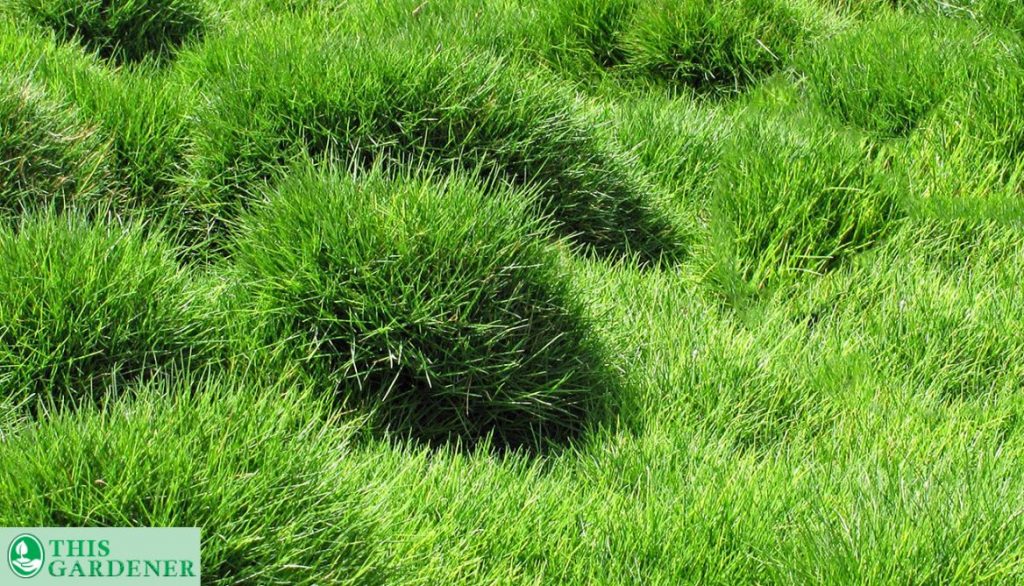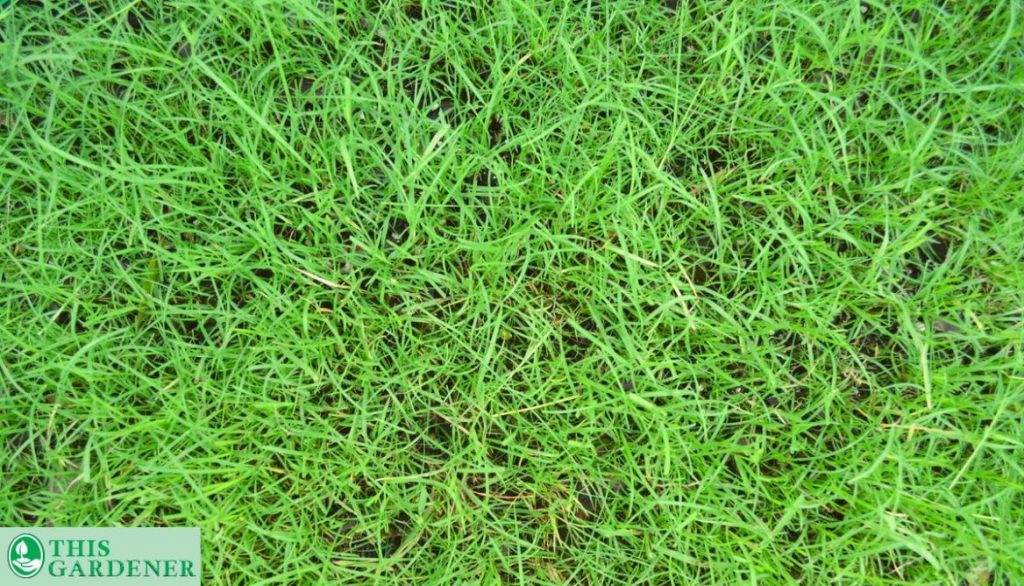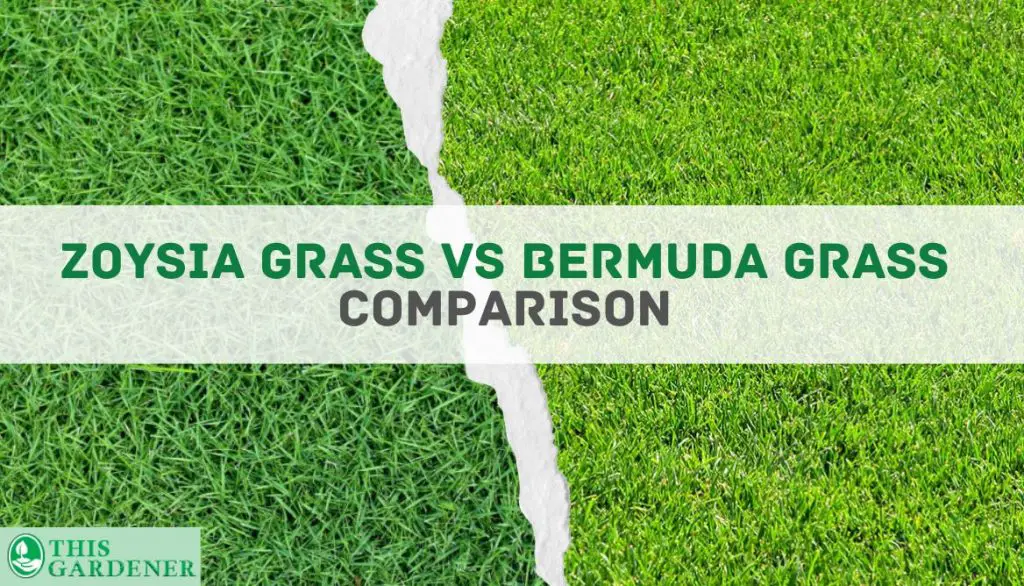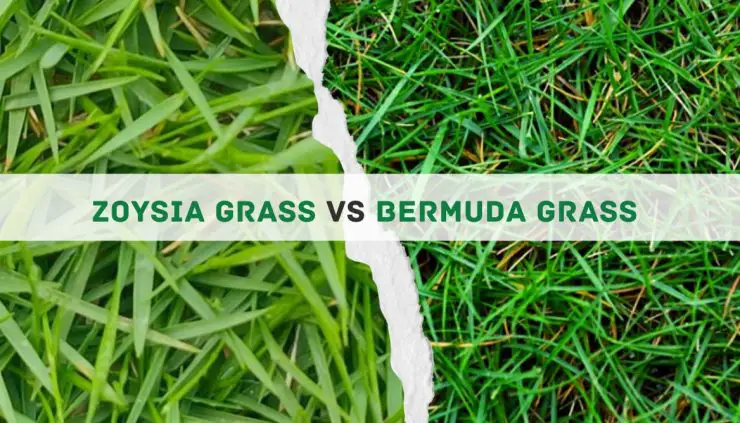The most significant difference between Zoysia grass vs Bermuda is their weather tolerance.
Both grass types can provide pristine lawns when properly maintained and are often used on golf courses for that reason. Zoysia will be fine in cool, shady locations, but Bermuda grass is a warm-season grass that requires heat and plenty of sunlight in order to thrive.
Reasons to choose Zoysia grass:
- Much more shade tolerance than a lot of the other warm-season grasses.
- Also choking out weeds on its own because it grows so thick.
- Can withstand partial shade and moderate drought resistance.
Reasons to choose Bermuda grass:
- Bermuda grass offers strong, durability, especially in warmer conditions.
- Is not only strong it can recover faster than many other types of grass.
- Diseases rarely affect its leaves and roots.
Contents
A Quick Comparison of Zoysia vs Bermuda grass
Zoysia does not require special care, and since it is a warm-season grass, it feels very good in drought conditions. This grass kind can be a great choice for you if you don’t enjoy watering or mowing your lawn.
Bermuda grass requires a hot weather species. You will struggle to keep a lush green lawn without full sun and warm temperatures. The good news is that it grows so well in the right conditions that you can simply lay grass seed and avoid the hassles of sod or plugs.
Key Differences Between Zoysia grass vs Bermuda
Parameters | Zoysia Grass | Bermuda Grass |
Shade Tolerance | Higher | Moderate |
Soil pH | 6.0 – 6.5 | 6.5 – 8.0 |
Needs for Water | Nearly once a week | Every third or fourth day |
Soil Preference | Sandy and loamy, Clay | From heavy clays to deep sands |
Fertilizer Requirements | Need a nitrogen-rich fertilizer | (16-0-8) N-P-K ratio |
Sun Temperature Requirements | Best grows, above 80°F | Between 95° - 100°F |
What is Zoysia grass?

In many countries, zoysia can be found as a drift plant. In the US, this plant is cultivated for lawn decoration and is also used for a lawn on golf courses.
The best-known zoysia species are Zoysia japonica, Zoysia matrella, and Zoysia tenuifolia.
Identifying Zoysia grass
- The grass is lush and dense.
- The leaf is wrapped around the bud.
- When winter comes, the thick grass turns brown.
- The leaf blade is rigid and short.
Pros and cons of choosing Zoysia
What is Bermuda?

Bermuda grass is a warm-season turfgrass that thrives throughout the hot summer months. It is drought tolerant, so if your area is a hot spot, it is an excellent choice for the front lawn.
Bermuda grass also has a large root system, which makes it one of the most resilient lawn grasses in the world.
Identifying features of Bermuda.
- Very fine leaf blades.
- Always a true dark green, even though they’re different shades.
- Coarse texture and tough aboveground roots.
- Stolons are flat, smooth, and generally curved, with roots at nodes.
Pros and cons of choosing Bermuda
Сomparing Zoysia vs Bermuda

Appearance
Zoysia grass is often light to medium green color. When winter dormancy sets in, it turns brown, although it stays green considerably longer than Bermuda grass.
Bermuda grass has a dark green leaf blade and grows radially from rhizomes and stolons once established, forming vast areas on lawns.
Weeds, growth, and sod formation
Dandelion and clover are the most prevalent broadleaf weeds found in zoysia and Bermuda grass lawns.
Your hands and a piece of decent gardening equipment are the finest organic weed killers. Weeding is an efficient, focused method of weed control on a lawn:
- Weeds should be dug up by the root with garden equipment such as a dandelion digger or a sickle blade.
- Weed seeds can remain dormant for years, so don’t dig too deeply to avoid perpetual weeds.
- Weed often and early. Begin in early spring, before weeds have a chance to develop.
- Regularly hoe planting beds with a dutch or push hoe.
Advice: Wet the soil before weeding to make plucking garden weeds simpler.
Under ideal growth circumstances, the contents of zoysia grass seed germinate for about 15 to 22 days. Bermuda seeds could grow in 7 to 14 days.
Zoysia and Bermuda grass sod forming that spreads by stolons, rhizomes, and grass seed.
Best Uses for Zoysia vs Bermuda grass
Zoysia has excellent traffic tolerance and is used for a variety of applications, including golf bluish green, tennis courts, and lawns.
Common Bermuda grass is exceptionally drought tolerant and durable, best suited in high-traffic areas like sports fields, golf courses, and sports playgrounds.
Soil Types and pH Needs
It’s very important to choose the right soil type and pH needs, for your grass type. Zoysia needs soil that is somewhat acidic and soil pH should be between 6.0 – 6.5. Bermuda grassseed requires slightly acidic soil and soil pH is around 6.0 – 7.0.
Water Needs
Zoysia grass must be watered at least once per week and watering carefully and infrequently promotes deep drought-resistant roots. For Bermuda grass the conditions are slightly different, it should be watered at least 2 and preferably 3 times a week, and this includes precipitation.
Fertilizer requirements
For the Zoysia grass type, you can use close to four pounds of nitrogen fertilizer per 1,000 square feet of grass per year. The best time-tested mixture of fertilizers is 15-0-10 (15% of nitrogen, 0% phosphorus, and 10% of potassium) is the optimal fertilizer.
For Bermuda grass, the options are slightly different, it can get 3-4 pounds of nitrogen per growing season like zoysia 1,000 square feet of grass.
Sun, Shade, and Temperature Requirements
Zoysia grass grows in partial shade, but preferably from 4-6 hours of sunlight, the favorable temperature will be from 60°- 75°F.
Bermuda grasses need a temperature around 90° – 100°F and the recommendation of sunlight is 7 hours a day. And it’s important to note that areas without sunlight can lead to thinning of Bermuda grass.
Durability
Zoysia grass has very high foot traffic and drought tolerance. It has high resistance to a variety of diseases, insects, and mechanical damage. In addition, it is a good sod binder, has good tolerance to shade, and is a very early maturing turfgrass.
Common Bermuda grass is a robust grass that can endure drought and extremely hot weather conditions. It can withstand heat and recover fast from drought, allowing it to thrive in hot, dry summers. It is also very useful and quick to recover from traffic, making it a good choice for families who struggle to play in the garden.
Common Pests and Diseases
Pests and diseases can destroy zoysia grass in less than a year. These threats include termites, mealy bugs, moles, earthworms, ants, clubbed or soft leaves, leaf spots, and dry rot.
Unfortunately, zoysia grass grows and does not naturally resist diseases as well as pests. Mealybugs cause leaf blight by injecting bacteria into plant leaves, which eventually kills off the leaves.
Bermuda grass suffers from some internal and external pests and diseases. Both can damage the grass’s foliage and cause aesthetic issues for homeowners. In addition, horned beetles- a pest native to the United States – feed on the foliage of Bermuda grass when they hatch in the summertime.
Hybrid Bermuda grass
There are also other types of Bermuda grass – the hybrid Bermuda grass. While modified regular Bermuda species are equally suitable for lawns, hybrid Bermuda grasses are preferred due to their unique characteristics. Insect and disease resistance is also improved in hybrid types.
As with any plant, proper maintenance is essential for keeping a Bermuda lawn healthy. For example, you can avoid direct sun exposure by encouraging shade wherever possible.
Mowing Needs
Zoysia grass needs frequent mowing to stay short and to maintain good color. Zoysia grass has an active growth cycle and needs to be cut down at least once a week to maintain its growth. It can tolerate a bit of heat, but it will look much better if it is cut back in early summer.
Bermuda grass needs to be mowed regularly to keep it looking good and healthy. Mowing provides nutrients to the plant cells since part of it is chopped off each time it grows back.
In addition, mowing disposes of leaves and other unwanted materials from your lawn. It also keeps your lawn neat so people can easily walk in your yard without tripping over twigs or leaves.
Cost of Maintenance
The cost of zoysia grass maintenance is directly proportional to the care and maintenance have given to the turf. Sullied lawns require extra attention and maintenance due to excessive wear and tear caused by foot traffic and weather conditions.
Typically, zoysia requires little to no fertilization either. Fertilizer applied to the soil directly nourishes the zoysia grass blades. This abundant growth makes zoysia grass one of the most durable types of lawns in existence.
Bermuda grass is a very popular lawn type because it is both low-maintenance and attractive. However, the cost of maintaining Bermuda grass is high.
It requires frequent mowing and watering, which can be expensive. If the grass blades are not maintained, they can become overgrown and difficult to manage.
Zoysia vs Bermuda grass: Which Option is Right for You?
Zoysia grass is best for a lawn, as it is easier to maintain than Bermuda grasses. If you have a heavy foot traffic area, where people walk barefoot and pick up any debris you may wish to consider an area of turf for such use.
Bermuda grass is a good choice for a small area. It is the most drought-tolerant of the grasses. It has a strong root system and grows thick. It is also drought resistant.
Zoysia grass wins here because it grows faster than other grasses, and it holds water and nutrients better than other grasses also It is very durable and is very resistant to weeds and insects.
Choosing the Best Option for Climate
Zoysia is a warm-season grass and it’s best to plant it in the fall when the days are getting cooler. It does best in the spring and fall. Zoysia is a grass that can take a lot of suns, but it does best with the cooler temperatures in the fall.
The late spring and summer months are ideal for growing Bermuda grass. This is the stage during which the plant is actively developing and creating a lot of growth. This is also the time when the plant matures and is ready for harvest.
The key to having a beautiful lawn is to feed it on a regular basis. Aside from feeding, it is critical to water the grass on a regular basis.
Growing zones
Planting zones (6-11) of the USDA are good for cultivating zoysia grass, and plant hardiness zones (7-10) apply to Bermuda grass.
Summary: Zoysia is a grass that can take a lot of suns, but it does best with the cooler temperatures in the fall. Late spring and summer months are ideal for growing Bermuda grass. Plant hardiness zones (7-10) apply to Bermuda grass and USDA zones (6-11) of the USDA are good for zoysia grass.
Choosing the Best Option Based on Maintenance
When we compare Zoysia grass vs Bermuda zoysia grass, zoysia grass is a good option for those who want less maintenance.
Most zoysia grass lawns require little maintenance and only require occasional liming when the pH drops below 6. Otherwise, it is the best species for anyone who wants an almost completely barefoot lawn, with excellent ground cover and low water requirements.
Because it is drought and heat tolerant, no additional watering is required during the hot summer months.
Summary: Choosing the Best Option Based on MaintenanceWhen we compare Zoysia grass vs Bermuda zoysia grass, zoysia grass is a good option for those who want less maintenance.
Choosing the Best Option Based on Susceptibility to Pests and Disease
Zoysia exhibits comparable pest and disease resistance to other warm-season grasses when appropriately maintained. Brown Patch, Dollar Spot, Army Worms, Billbugs, and SodWebworms, on the other hand, can pose difficulties if they are not properly maintained.
Susceptible to anthracnose, blue mold, and powdery mildew.
Bermuda grass is very susceptible to the yellowing and wilting symptoms of white root rot. This disease can be controlled by thorough soil cultivation and by not planting Bermuda grass in areas where white root rot has been reported.
Summary: Zoysia exhibits comparable pest and disease resistance to other warm-season grasses when appropriately maintained. Brown Patch, Dollar Spot, Army Worms, Billbugs, and SodWebworms pose difficulties if they are not properly maintained. Bermuda grass is susceptible to the yellowing and wilting symptoms of white root rot.
What are the similarities between Zoysia vs Bermuda grasses?
Low-maintenance needs
Both species of grass are low-maintenance. Temperatures should not reach 70°F during the day and 50°F at night.
Otherwise, it is the best species for anyone who wants an almost completely barefoot lawn, with excellent ground cover and low water requirements.
Adaptability
Both zoysia and Bermuda are adaptable and may be utilized for a range of applications. Bermuda grass, on the other hand, may be blended with a variety of grasses.
Growing on variety of soil types
Zoysia and Bermuda grass may grow in a wide range of soil types. They are excellent grass species for a variety of conditions. If grass does get damaged, it grows back quickly without any human intervantion needed.
FAQ
Can I mix Bermuda grass with Zoysia?
You can mix the two species of grass, but it is not encouraged since the zoysia grass will begin to displace the Bermuda grass within one or two seasons.
Is Bermuda or Zoysia better?
Bermuda grass is an ideal lawn in many situations. It grows well on sunny lawns, sandy soils, and areas where temperatures rise and remain high for most of the year. It’s a gorgeous dark green color that will completely transform your environment. It handles heat and drought well.
Zoysia is a good choice if you want a soft lawn that keeps weeds out. It requires more maintenance than Bermuda shorts, but the color and rough texture are hard to match.
How do I switch from Bermuda grass to Zoysia?
If you plan on seeding, you will need to remove the old grass. There are ways to do this without mowing the lawn, but it is a lot of work. You need to find a way to get the old grass up off the ground.
If you have a mulching reel mower, you can cut the grass a few inches below the ground, then use a broom to get the clippings up into a pile.
After that, apply compost and fertilizer to the new grass and water it thoroughly.
Does zoysia spread like Bermuda?
Zoysia grass is easier to keep under control than Bermuda. Zoysia is not as fast-growing as Bermuda and is much more drought-tolerant.
Zoysia has a clumping habit so it can be difficult to maintain. It’s not as fast-growing as a Bermuda, but it’s about as thick.
Will Zoysia choke out Bermuda?
Zoysia grass is a fast-growing, invasive species that pose a threat to Bermuda. Zoysia grass will never totally smother Bermuda grass, but it will undoubtedly overtake Bermuda’s weaker places.
During the summer, if kept healthy and in the shade, zoysia will crowd out weeds and other grasses.
Is St. Augustine grass better than Zoysia?
Chinch bugs and billbugs are insects that enjoy eating zoysia grasses; however, chinch bugs are far more usually seen in St. Augustine grass. EMPIRE is zoysia resistant to chinch bugs. For this reason, many Florida homeowners switch from St. Augustines to EMPIRE Zoysia. Innovation Zoysia has also been bred to be resistant to bluegrass billbugs. Bermuda grass mites, billbugs, and grub worms are common pests of Bermuda grass.
Conclusion
Zoysia grass and Bermuda grass are great grass species in a variety of conditions. It takes time for Zoysia to establish itself, but once it has displaced everything in its path, it stays. The most significant difference between Zoysia grass and Bermuda is their weather tolerance.
Bermuda grass, on the other hand, grows rapidly but requires many resources to continue growing and is susceptible to pests and diseases. Bermuda grass does not have the same level of hardiness as Zoysia, making it difficult to grow and care for in northern states.
It’s up to you which grass to choose and after a while, you can enjoy a beautiful lawn that complements your home activities, maintenance choices, and aesthetic goals.
And what grass did you prefer for your lawn, share your experiences in the comments, as well as share this post with your friends on social networks?
References
https://sodsolutions.com/insect-pest-control/insect-control-in-your-bermuda-grass-lawn/
https://lawnmowerguru.com/zoysia-grass-vs-bermuda/
https://www.gardenseeker.com/lawn-care/zoysia-grass-vs-bermuda/
https://hgic.clemson.edu/factsheet/zoysiagrass/
https://www.britannica.com/plant/Bermuda-grass/
- How to Get Potatoes to Sprout Eyes: Detailed Growing Guide with 3 Options - July 31, 2023
- Weight of a Medium Potato: Revealed in Detailed Guide - July 29, 2023
- Maris Piper Potatoes: 9 Substitutes You Should Know About - July 27, 2023
Hello! I’m Jessica Zander, a garden coach and consultant based in the Boston area (zone 6b), offering virtual consultations across the country and Canada.
I’ve been passionate about gardening since the early 1990s, and in 2022, I launched You Can Do It Gardening to empower individuals to feel more confident in their gardening endeavors.
Following a 30-year career in nonprofit finance and operations, I transitioned out of that field in mid-June of 2023 due to the growing demand for coaching services. Interestingly, my years of presenting financial statements to boards and finance committees proved to be valuable experience for teaching people about gardening! I enjoy sharing skills, providing guidance and suggestions, and collaborating efficiently with clients to make significant improvements to their outdoor spaces, both small and large. I also regularly teach at the Arlington Continuing Education and Cambridge Adult Education.
My approach is direct and practical, akin to Mary Poppins, but tailored to your garden. Clients find satisfaction in saving money and taking pride in their own gardening achievements.



Add comment